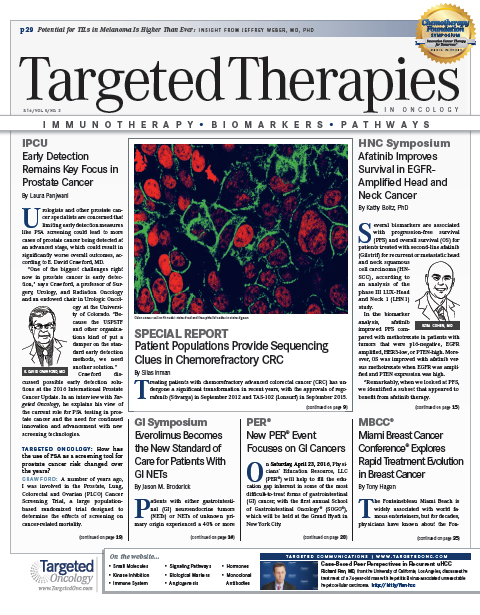Cetuximab Improves Long-Term Disease Control in HPV-Negative HNSCC
Adding cetuximab (Erbitux) to induction chemotherapy and hyperfractionated or accelerated chemoradiation therapy produced long-term control for patients with HPV-, locoregionally advanced head and neck squamous cell carcinoma with a poor prognosis.
Adding cetuximab (Erbitux) to induction chemotherapy and hyperfractionated or accelerated chemoradiation therapy (CRT) produced long-term control for patients with HPV-negative, locoregionally advanced head and neck squamous cell carcinoma (LA-HNSCC) with a poor prognosis, according to results from a phase II trial.
The randomized study, which was presented at the 2016 Head and Neck Cancer Symposium, enrolled 110 patients who were diagnosed with LA-HNSCC between September 2006 and April 2010. In 103 of these patients, HPV status was evaluated, and 56 were HPV-negative.
These 56 HPV-negative patients were randomized to 2 treatment arms: 32 patients received Cetux-FHX (concurrent cetuximab, 5-FU, hydroxyurea, and 1.5 Gy twice-daily RT every other week to 75 Gy), and 24 patients received Cetux-PX (cetuximab, cisplatin, and accelerated RT with delayed concomitant boost to 72 Gy in 42 fractions). Both arms received 2 cycles of weekly induction chemotherapy.
Previous phase II trials indicated cetuximab was well tolerated and had high response rates when added to induction chemotherapy, though these trials were not randomized. Research has also previously shown that cetuximab increased survival in the metastatic setting when added to cytotoxic chemotherapy and in the curative-intent setting when added to single-modality radiotherapy.
“The primary objective for this trial was to assess the tolerability and efficacy of adding cetuximab to induction chemotherapy and chemoradiotherapy. A secondary objective with this trial was to compare 2 chemoradiotherapy platforms,” said lead study author James Melotek, MD, a radiation oncology resident at the University of Chicago.
Overall survival (OS) at 5 years for the entire cohort was 80.3% (95% CI, 73.1%-88.3%) and for the HPV-negative subset was 72.5% (95% CI, 61.6%-85.4%). Progression-free survival (PFS) at 5 years was 74.1% (95% CI, 66.3%-82.9%) for the entire cohort and 65.9% (95% CI 54.6%-79.6%) for the HPV-negative group.
No significant difference was found in OS (P= .43) or PFS (P= .57) between the two HPV-negative treatment arms. Five-year OS was 71.4% (95% CI, 57.1%-89.1%) for the Cetux-FHX arm and 74.2% (95% CI, 58.4%-94.3%) for the Cetux-PX arm. Median follow-up was 68 months.
PFS at 5 years was 62.1% (95% CI, 47.2%-81.6%) for the Cetux-FHX arm and 70.8% (95% CI, 54.8%-91.6%) for the Cetux-PX arm. Late outcomes in the HPV-negative subset at 5 years were locoregional failure in 26.9% (95% CI, 16.0%-39%) and distant failure in 7.2% (95% CI, 2.3%-16%).
Neither OS nor PFS were affected by tobacco use, alcohol use, or HPV status. For both OS and PFS, however, age was a significant predictor (HR, 1.07; 95% CI, 1.02-1.12;P= .007).
Patient demographics were comparable between the 2 arms. Median age was 57 years (range, 32-81 years). Most of the patients (84%) were male. Almost all (98%) patients had stage IV carcinomas (61% ≥T3, 77% ≥N2b, 54% T4 or N3). The majority (66%) of patients smoked ≥10 packs per year.
The induction chemotherapy had an overall response rate of 91%. Severe toxicity during induction chemotherapy was limited to rash and myelosuppression. Rash grade ≥3 occurred in 23% of patients, and neutropenia ≥3 occurred in 38% of patients.
Each arm had distinct adverse events (AEs) with CRT. The Cetux-FXH arm had increased dermatitis, with grade ≥3 dermatitis in 81% of patients versus 51% in the Cetux-PX arm (P<.01). The Cetux-PX arm had increased myelosuppression, with grade ≥3 neutropenia in 38% of patients versus 18% in the Cetux-FHX arm (P= .018), and increased dehydration, with grade ≥3 dehydration in 17% of patients versus 2% in the Cetux-FHX arm (P<.01). One death (sepsis) occurred on the Cetux-PX arm.
“In conclusion, the addition of cetuximab to induction chemotherapy and chemoradiotherapy in this trial was tolerable and produced long-term control of locally advanced head and neck cancer, particularly among poor-prognosis, HPV-negative patients. Both chemoradiotherapy platforms were well tolerated without any significant differences in survival,” said Melotek.
He suggested that additional investigation of cetuximab might be merited in the neoadjuvant setting with intensification of treatment in high-risk subgroups and in the concurrent setting with nonplatinum-based CRT.
References
- Melotek JM, Haraf DJ, Blair EA, et al. Final results of a randomized phase 2 trial investigating the addition of cetuximab to induction chemotherapy and accelerated or hyperfractionated chemoradiation therapy for locoregionally advanced head and neck cancer: HPV-negative subset analysis. Presented at: 2016 Multidisciplinary Head and Neck Cancer Symposium; Feb 18-20, 2016; Scottsdale, AZ. Abstract 7.

Gasparetto Explains Rationale for Quadruplet Front Line in Transplant-Ineligible Myeloma
February 22nd 2025In a Community Case Forum in partnership with the North Carolina Oncology Association, Cristina Gasparetto, MD, discussed the CEPHEUS, IMROZ, and BENEFIT trials of treatment for transplant-ineligible newly diagnosed multiple myeloma.
Read More
Key Trials From ASH 2024 Impact Treatment for Plasma Cell Disorders Going Forward
February 20th 2025Peers & Perspectives in Oncology editorial board member Marc J. Braunstein, MD, PhD, FACP, discussed the significant advancements in multiple myeloma treatment at the 2024 ASH Annual Meeting and Exposition.
Read More